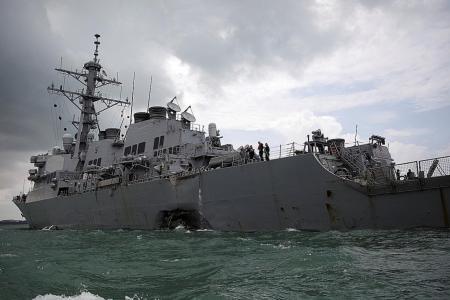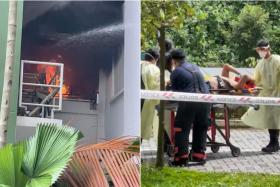‘Sudden turn’ led to collision of US warship: Report
Transport Ministry unit releases report on USS John S. McCain accident
An accident involving a US warship and an oil tanker, which occurred in Singapore waters last August and left 10 people dead, was brought on by a "sudden turn" made by the warship.
Less than three minutes later, the American guided-missile destroyer USS John S. McCain collided with oil tanker Alnic MC as they were transiting through the Singapore Strait.
The warship was in the path of the oil tanker, said the Transport Safety Investigation Bureau (TSIB) - a unit under the Transport Ministry - which released its report yesterday.
Ten American sailors on board the McCain died in the accident, which occurred at 5.24am near Pedra Branca.
In a 35-page report made public yesterday, TSIB said the action by the US warship resulted from a series of missteps that took place after a transfer of propulsion controls.
Instead of one crew member managing both speed and steering, the US commanding officer had ordered another member to take over managing speed minutes before the accident.
Inadvertently, along with speed, the steering operations on the US warship also got transferred to the second crew member.
The sailor who was originally in charge of steering reported a loss of steering.
Alternative steering kicked in, while speed was reduced.
But because the throttles on each side of the ship were not coupled, the left side ended up slowing down more than the right, and the US warship veered left, into the path of the Alnic.
In its report, TSIB said the crew of the US warship did not recognise the processes involved in the transfer of propulsion and steering control.
'LACK KNOWLEDGE'
They were "likely to have lacked the requisite knowledge of the steering control system due to inadequacies in training and familiarisation".
Before the vessels collided, the captain of the Alnic had seen the US warship, but his vessel's Automatic Identification System (AIS) was not picking up any signals from the warship.
It was later determined that the McCain had not switched on its AIS - which reveals information such as a ship's location, identity, speed and direction of travel - to other vessels in the area and monitoring stations.
The Alnic's captain tried to contact the McCain, but there was no response.
He at first assumed the warship would be able to pass safely.
Fearing a collision several moments later, he then ordered speed reduced but did not change direction or immediately try to stop his vessel.
By the time he tried to stop completely, it was too late.
The TSIB report pointed out that the tanker captain had not alerted his crew to the danger of a collision and that he was not supported by enough manpower on the bridge.
The report is consistent with findings by the US Navy, which conducted its own investigations, the results of which were made public last November.
Two months after the collision, the commanding officer of the McCain, Alfredo J. Sanchez, was relieved of his duties, along with executive officer Jessie L. Sanchez.
Following the accident, the US Navy has also issued a directive stating that during voyage, the AIS on all vessels must be switched on, especially in congested waterways.
Get The New Paper on your phone with the free TNP app. Download from the Apple App Store or Google Play Store now


